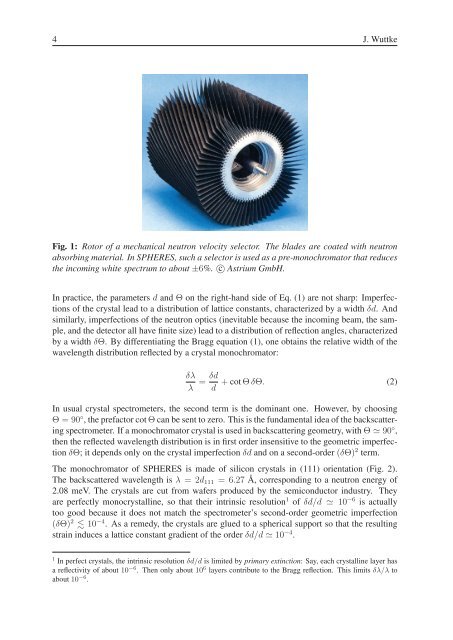Neutron Scattering - JUWEL - Forschungszentrum Jülich
Neutron Scattering - JUWEL - Forschungszentrum Jülich
Neutron Scattering - JUWEL - Forschungszentrum Jülich
Create successful ePaper yourself
Turn your PDF publications into a flip-book with our unique Google optimized e-Paper software.
4 J. Wuttke<br />
Fig. 1: Rotor of a mechanical neutron velocity selector. The blades are coated with neutron<br />
absorbing material. In SPHERES, such a selector is used as a pre-monochromator that reduces<br />
the incoming white spectrum to about ±6%. c○ Astrium GmbH.<br />
In practice, the parameters d and Θ on the right-hand side of Eq. (1) are not sharp: Imperfections<br />
of the crystal lead to a distribution of lattice constants, characterized by a width δd. And<br />
similarly, imperfections of the neutron optics (inevitable because the incoming beam, the sample,<br />
and the detector all have finite size) lead to a distribution of reflection angles, characterized<br />
by a width δΘ. By differentiating the Bragg equation (1), one obtains the relative width of the<br />
wavelength distribution reflected by a crystal monochromator:<br />
δλ<br />
λ<br />
= δd<br />
d<br />
+ cot Θ δΘ. (2)<br />
In usual crystal spectrometers, the second term is the dominant one. However, by choosing<br />
Θ=90◦ , the prefactor cot Θ can be sent to zero. This is the fundamental idea of the backscattering<br />
spectrometer. If a monochromator crystal is used in backscattering geometry, with Θ � 90◦ ,<br />
then the reflected wavelength distribution is in first order insensitive to the geometric imperfection<br />
δΘ; it depends only on the crystal imperfection δd and on a second-order (δΘ) 2 term.<br />
The monochromator of SPHERES is made of silicon crystals in (111) orientation (Fig. 2).<br />
The backscattered wavelength is λ =2d111 =6.27 ˚A, corresponding to a neutron energy of<br />
2.08 meV. The crystals are cut from wafers produced by the semiconductor industry. They<br />
are perfectly monocrystalline, so that their intrinsic resolution1 of δd/d � 10−6 is actually<br />
too good because it does not match the spectrometer’s second-order geometric imperfection<br />
(δΘ) 2 � 10−4 . As a remedy, the crystals are glued to a spherical support so that the resulting<br />
strain induces a lattice constant gradient of the order δd/d � 10−4 .<br />
1 In perfect crystals, the intrinsic resolution δd/d is limited by primary extinction: Say, each crystalline layer has<br />
a reflectivity of about 10 −6 . Then only about 10 6 layers contribute to the Bragg reflection. This limits δλ/λ to<br />
about 10 −6 .

















